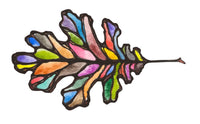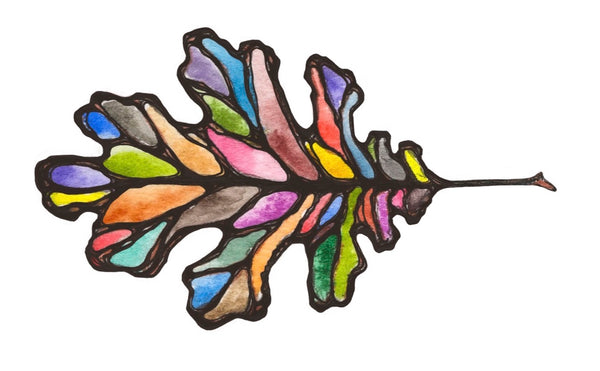Viridian Watercolor Paint, Half Pan
Greenleaf & Blueberry Professional Handmade Watercolors
Color Overview
| Color Name | Viridian |
| Pigment | Viridian (Hydrated Chromium Oxide) |
| Pigment Index No. | PG18 |
| Chemical Formula |
|
| Series No. | Series 5 |
| Lightfastness Rating | 5/5 Very Lightfast |
| Toxicity | 2/5 California recognizes trace amounts of a possible manufacturing bi-product a possible carcinogen |
| Hue | Green Category |
| Chroma | 4/5 Moderate to High Chroma |
| Transparency | 1/5 Transparent |
| Pigment Type | Synthetic |
| Granulation | Yes |
| Value Range | 4/5 Moderate to High Range |
| Tinting Strength | 3/5 Moderate Strength |
| Staining | No Staining |
| Flocculation | 2/5 Dispersing |
| Variegation | No |
| Combination Swatch |
 |
| Gravity Wash Swatch |
 |
| Value Scale Swatch |
 |
Color Description
Our Viridian displays a cool, blue-ish green. It has a wide value range, but only moderate tinting strength, making this a wonderfully buildable color.
This color disperses nicely, but not wildly, and granulates beautifully. It is also very transparent, making it an excellent choice for glazing.
A classic pigment on the watercolor palette, it dazzles at full concentration in our version.
Each of the following swatched have been painted onto Arches Cold Pressed 140 lb. watercolor paper.
Color Story
Viridian is a synthetic pigment that was discovered in the ninetheenth century. It was a very significant find because as a lightfast and non-toxic brilliant green, it speedily replaced the poisonous Emerald Green that was in use at the time.
A French Chemist known as Pannetier developed the first true Viridian pigment in 1838, and was kept secret. It seems another color chemist stumbled into the reaction and patented the process in 1859. Ten years later it was introduced by Winsor & Newton as an artist's color.
Well-known artists such as Van Gogh and other French Impressionists used it in their work. Since then, it has become a staple on the watercolorist's palette in particular.
Swatches
Color behavior assessments and descriptions are of course somewhat subjective, your perception being determined by your watercoloring experience. We offer this information with the intent of giving you an accurate idea of how a color will look and handle so that you can determine if it is a good fit for your palette and painting practice.
Combination Swatch:

This swatch demonstrates:
- Opacity: Compare the two black lines, the top lines is drawn over the swatch and the bottom one is under the swatch. The more the bottom line has disappeared, the more opaque the color.
- Staining: The white line at the bottom of the swatch was lifted out. The whiter the line, the less staining the color.
- Value Range: Color is painted from most concentrated (at left) to least concentrated at right. The closer a color is to black at most concentrated, the wider its value range. (All watercolors painted onto white paper can be diluted to complete transparency, or white.)
Gravity Wash Swatch:

This swatch demonstrates:
(A Gravity Wash Swatch is made by pre-wetting the paper, then holding it vertically at an angle, and applying paint from left to right at the very top of the wetted area.)
-
Granulation: Granulation display is influenced both by pigment particle size and behavior determined by chemical composition. Granulating colors are recognizable in Gravity Washes through their patterned and textured appearance.
-
Flocculation: Flocculation is the tendency for a color's pigment particles to cling together or be attracted to one another. Dispersion is the opposite. A flocculating color is recognizable in a Gravity Wash by a "jellyfish" appearance with the downward movement of the pigment resembling tentacles, while a dispersing color more resembles a distant rainstorm, as is the case with Viridian.
-
Variegation: Variegation is the tendency for a color's pigment to express itself as more than one hue, usually as a result of a range of pigment particle sizes. In a Gravity Wash, pigment particles have an opportunity to settle by size a bit, with the smaller particles getting carried further to the edges of where the color travels. If you only notice one hue in a gravity wash, then it is likely not a variegating color.
- Tinting Strength: It can be difficult to determine tinting strength in controlled color swatches. Because Gravity Washes are less controlled, you can get a more unvarnished look at a color, enabling you to assess characteristics you usually only catch glimpses of when painting. Colors that appear very dark, intense, and that cover more of the wash area have a more intense tinting strength, while colors that appear more faint and taper out before reaching the bottom of the swatch have a weaker tinting strength.
Value Scale Swatch:
This swatch is painted in layers, starting with the lightest/least concentrated, and letting each layer dry before the next more concentrated layer is added. The leftmost and most concentrated layer is applied at a maximum concentration, which is generally not how watercolors are most often used, however this swatch is designed to display the full value range of a color.

This swatch demonstrates:
Value Range: Value range is a color's range from darkest (most concentrated) to lightest (least concentrated/most diluted). Value range is arguably one of the most important aspects of any watercolor. This type of swatch allows you to hold up a magnifying glass to that characteristic.
Our Pans
We work with standard white plastic Half-Pans. They are therefore durable and lightweight. They also fit into most metal bijoux boxes and watercolor travel boxes.
Size Measurements: 2cm x 1.7cm x 1cm
Half-Pans are a great choice for artists who are going for a minimalist approach and tend to seek all of their supplies in tiny lightweight versions and for artists who love to carry as many colors as possible while still managing space and weight. They are also a nice way to try out a color that is new to you.
More Information
- Overview of Pigments
- What Makes Our Colors Different
- How To Pick Colors & Create Your Perfect Watercolor Palette
Other Items You Might Find Useful For Watercolor Painting
Please be aware that every monitor and screen displays colors a little differently. We have done our very best to show our colors as they appear in person and on paper.
**Please Note**: These colors are NOT intended for children. Half-Pans are small and therefore a choking hazard. Please use only as intended.
All images and descriptions are copyrighted by Greenleaf & Blueberry®
© Greenleaf & Blueberry LLC 2011-2024










